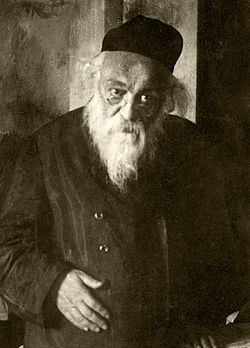Top Qs
Timeline
Chat
Perspective
Chaim Soloveitchik
Belarusian rabbi From Wikipedia, the free encyclopedia
Remove ads
Chaim (Halevi) Soloveitchik (Yiddish: חיים סאָלאָווייטשיק, Polish: Chaim Sołowiejczyk), also known as Chaim Brisker (1853 – 30 July 1918), was a rabbi and Talmudic scholar credited as the founder of the Brisker method of Talmudic study within Judaism. He was also a member of the Soloveitchik dynasty, the son of Yosef Dov Soloveitchik.[1]
He is also known as the Gra"ch (Hebrew: גר״ח), an abbreviation of "HaGaon Reb Chaim."
Remove ads
Biography
Soloveitchik was born in Volozhin on March 25, 1853, where his father, Rabbi Yosef Dov Soloveitchik was a lecturer in the Volozhiner Yeshiva.[2] The family moved away from Volozhin,[3] and after a few years his father was appointed as a rabbi in Slutsk, where Chaim was first educated.[4]
He joined the faculty of the Volozhiner Yeshiva in 1880, and later became assistant rosh yeshiva[3] for a short time, until the Russian Empire forced the yeshiva to close, when he moved to Brisk, Belarus and succeeded his father as the rabbi there.[4][5]
He died on July 30, 1918 after seeking medical treatment in Warsaw and was buried in the Jewish Cemetery there.[6][7]

Remove ads
Works
He is considered the founder of the "Brisker method" (in Yiddish: Brisker derech; Hebrew: derekh brisk), a method of highly exacting and analytical Talmudical study that focuses on precise definition/s and categorization/s of Jewish law as commanded in the Torah.[8] His works would have particular emphasis on the legal writings of Maimonides.[9][10]
Soloveitchik's primary work was Chiddushei Rabbeinu Chaim, a volume of insights on Maimonides' Mishneh Torah which often would suggest novel understandings of the Talmud as well.[11] Based on his teachings and lectures, his students wrote down his insights on the Talmud known as Chiddushi HaGRaCh Al Shas. This book is known as "Reb Chaim's stencils" and contains analytical insights into Talmudic topics.
Remove ads
Views
Soloveitchik worked with Sholom Dovber Schneersohn, the fifth rebbe of the hasidic dynasty of Lubavitch, in counteracting antisemitic decrees by the czarist regime.[9][12] He expanded the definition of who represented Amalek, claiming that all who sought to destroy the Jewish people were ideological descendants of the Jewish enemy.[13]
Soloveitchik was an opponent of Zionism and viewed it as a movement to destroy traditional Judaism and replace it with nationalism.[14]
Family
Summarize
Perspective
A member of the Soloveitchik-family rabbinical dynasty, he is commonly known as Reb Chaim Brisker ("Rabbi Chaim [from] Brisk").
He married the daughter of Refael Shapiro, who was also the granddaughter of Berlin.[3] Reb Chaim had four children, R. Yisrael Gershon, R. Moshe, Sara (Glickson), and R. Yitchak Zev (also known as Rabbi Velvel Soloveitchik). R. Moshe moved to the United States and subsequently served as a rosh yeshiva of Yeshiva Yitzchak Elchonon (YU/RIETS) in New York and who was in turn succeeded by his sons Joseph B. Soloveitchik (1903–1993) and Ahron Soloveichik (1917-2001). R. Yitzchak Zev moved to Israel and his sons led prominent yeshivas.[15]
| |||||||||||||||||||||||||||||||||||||||||||||||||||||||||||||||||||||||||||||||||||||||||||||||||||||||||||||||||||||||||||||||||||||||||||||||||||||||||||||||||||||||||||||||||||||||||||||||||||||||||||||||||||||||||||||||||||||||||||||||||||||||||||||||||||||||||||||||||||||||||||||||||||||||||||||||||||||||||||||||||||||||||||||||||||||||||||||||||||||||||||||||||||||||||||||||||||||||||||||||||||||||||||||||||||||||||||||||||||||||||||||||||||||||||||||||||||||||||||||||||||||||||||||||||||||||||||||||||||||||||||||||||||||||||||||||||||||||||||||||||||||||||||||||||||||||||||||||||||||||||||||||||||||||||||||||||||||||||||||||||||||||||||||||||||||||||||||||||||||||||||||||||||||||||||||||||||||||||||||||||||||||||||||||||||||||||||||||||||||||||||||||||||||||||||||||||||||||||||||||||||||||||||||||||||||||||||||||||||||||||||||||||||||||||||||||||||||||||||||||||||||||||||||||||||||||||||||||||||||||||||||||||||||||||||||||||||||||||||||||||||||||||||||||||||||||||||||||||||||||
| Notes:
| |||||||||||||||||||||||||||||||||||||||||||||||||||||||||||||||||||||||||||||||||||||||||||||||||||||||||||||||||||||||||||||||||||||||||||||||||||||||||||||||||||||||||||||||||||||||||||||||||||||||||||||||||||||||||||||||||||||||||||||||||||||||||||||||||||||||||||||||||||||||||||||||||||||||||||||||||||||||||||||||||||||||||||||||||||||||||||||||||||||||||||||||||||||||||||||||||||||||||||||||||||||||||||||||||||||||||||||||||||||||||||||||||||||||||||||||||||||||||||||||||||||||||||||||||||||||||||||||||||||||||||||||||||||||||||||||||||||||||||||||||||||||||||||||||||||||||||||||||||||||||||||||||||||||||||||||||||||||||||||||||||||||||||||||||||||||||||||||||||||||||||||||||||||||||||||||||||||||||||||||||||||||||||||||||||||||||||||||||||||||||||||||||||||||||||||||||||||||||||||||||||||||||||||||||||||||||||||||||||||||||||||||||||||||||||||||||||||||||||||||||||||||||||||||||||||||||||||||||||||||||||||||||||||||||||||||||||||||||||||||||||||||||||||||||||||||||||||||||||||||
Remove ads
References
External links
Wikiwand - on
Seamless Wikipedia browsing. On steroids.
Remove ads

